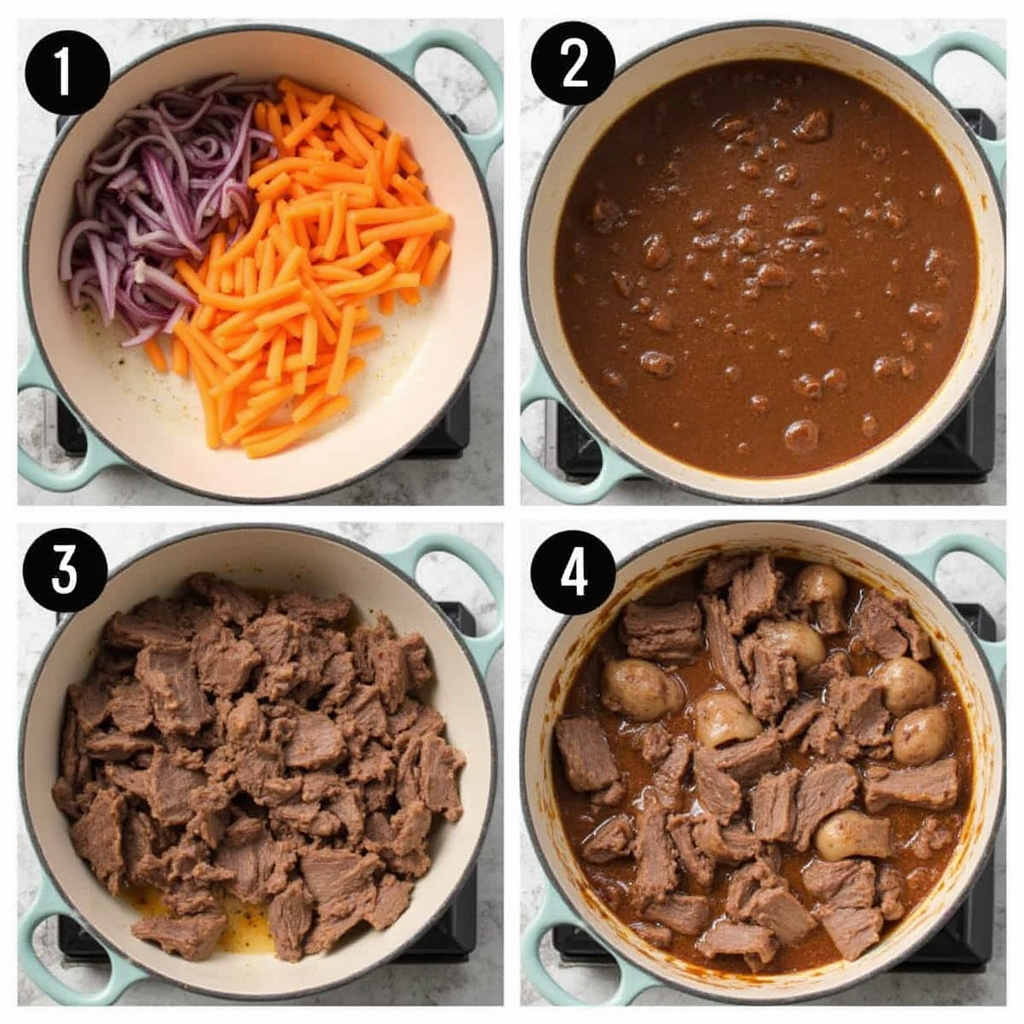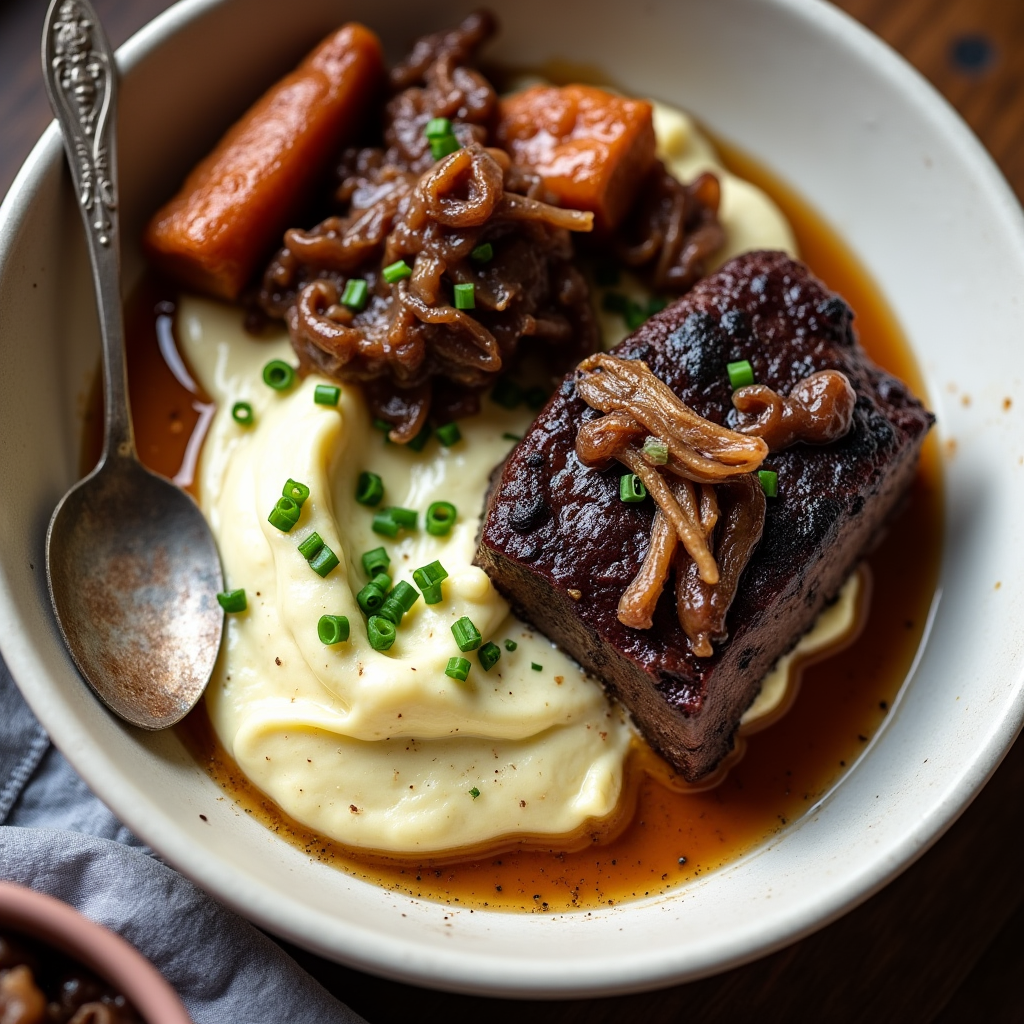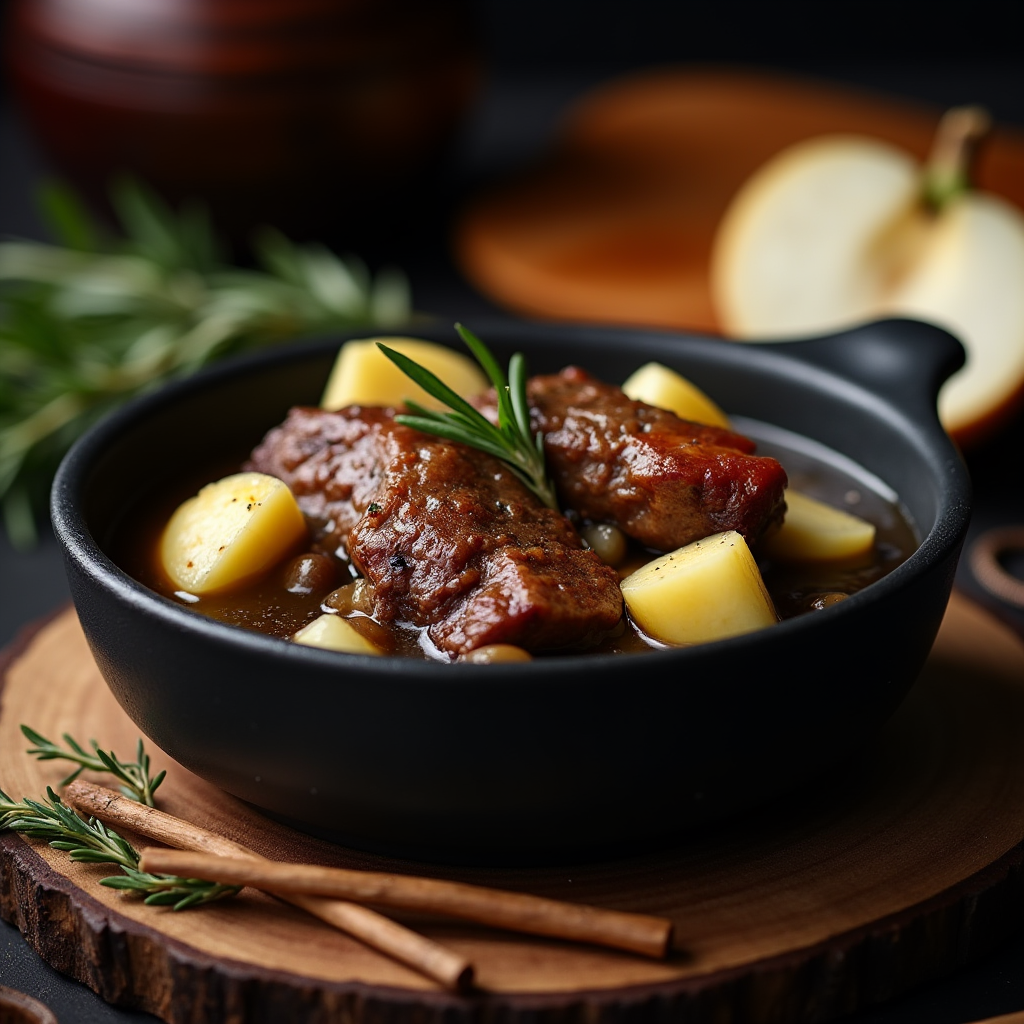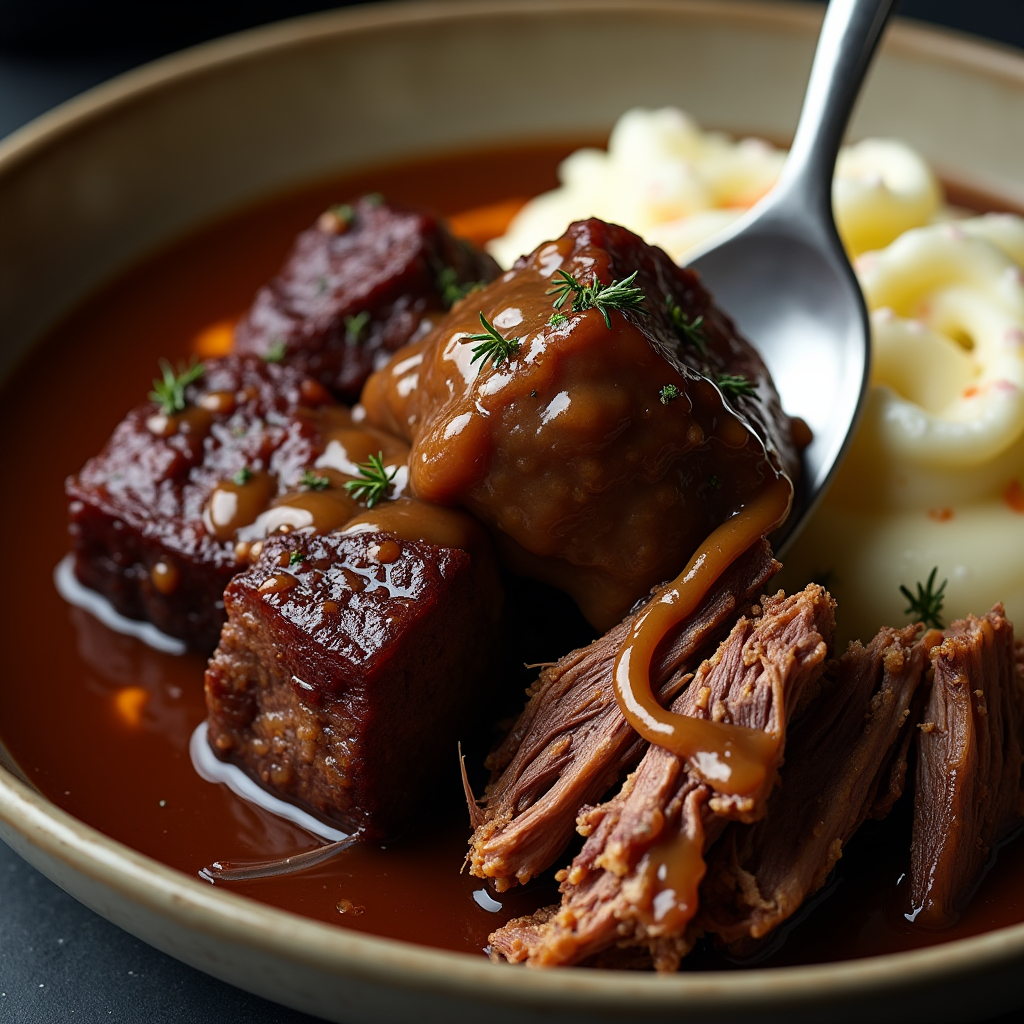Braised beef is a culinary delight that combines deep flavors and tender textures. Whether you’re preparing it for a family meal or an elegant dinner, mastering this dish ensures a satisfying experience. This article provides an in-depth look at how to perfect braised beef, from selecting the right cut to avoiding common mistakes.
The Science Behind Braising
Braising is a slow-cooking method that uses both wet and dry heat to break down tough cuts of meat. The process involves browning the beef in a hot pan, then cooking it in liquid at a low temperature over an extended period. This method transforms braised beef into a dish that’s rich in flavor and melt-in-your-mouth tender.
The key to this transformation lies in collagen. Found in connective tissues, collagen breaks down into gelatin when cooked slowly, imparting a luscious texture to the dish. Maintaining a consistent low heat throughout the process ensures optimal results. Using a tight-fitting lid during braising helps retain moisture, ensuring the beef remains juicy.
Choosing the Right Cut of Beef
Selecting the right cut of beef is critical for achieving tender braised beef. Cuts with ample connective tissue and fat marbling are ideal. These attributes ensure the beef remains moist and flavorful during long cooking times.
Recommended Cuts for Braised Beef:
- Chuck Roast: Known for its rich marbling and deep flavor.
- Brisket: Perfect for slow-cooking, offering a silky texture.
- Short Ribs: An excellent option for robust and hearty dishes.
- Shank: Contains ample connective tissue, ideal for developing gelatin.
Avoid lean cuts like tenderloin or sirloin, as they lack the necessary fat and connective tissue to hold up during braising. Remember to ask your butcher for advice if you’re unsure which cut suits your recipe.
Essential Ingredients for Braised Beef
Crafting delicious braised beef requires more than just meat. The supporting ingredients play a pivotal role in building complexity and depth.
Key Components:
- Aromatics: Onions, garlic, carrots, and celery form the flavor base.
- Liquids: Beef stock, red wine, or even beer adds moisture and flavor.
- Herbs and Spices: Bay leaves, thyme, rosemary, and peppercorns enhance the profile.
- Acid: Tomato paste, balsamic vinegar, or crushed tomatoes balance the richness.
Use fresh and high-quality ingredients to ensure a nuanced flavor profile. Avoid overpowering the dish by maintaining a balance between the ingredients.
Step-by-Step Guide to Perfect Braised Beef

Achieving perfect braised beef requires patience and attention to detail. Follow these steps for a foolproof method:
- Preparation: Begin by patting the beef dry to ensure a good sear. Season generously with salt and pepper.
- Searing: Heat oil in a heavy-bottomed pot and sear the beef until deeply browned on all sides. This step builds flavor.
- Building the Base: Remove the beef and sauté aromatics until softened. Add tomato paste and cook briefly to enhance its sweetness.
- Deglazing: Pour in red wine or stock to scrape up browned bits from the pan. This step captures the essence of the beef’s flavor.
- Braising: Return the beef to the pot, add remaining liquids and herbs, then cover and cook at a low temperature for several hours.
Allow the dish to rest before serving to let the flavors meld.
Best Cooking Equipment for Braising
Choosing the right equipment can significantly impact your braised beef. Durable, heat-retentive cookware ensures even cooking and locks in moisture.
Ideal Tools for Braising:
- Dutch Oven: Heavy and oven-safe, it provides excellent heat distribution.
- Slow Cooker: Perfect for hands-off cooking with consistent low temperatures.
- Pressure Cooker: Cuts down cooking time while preserving tenderness.
- Roasting Pan: Suitable for larger cuts, paired with aluminum foil or a lid.
Investing in quality cookware pays off in the long run, ensuring reliable results every time.
Key Tips for Tender Braised Beef
A few simple techniques can make all the difference in achieving tender and flavorful braised beef. Keep these tips in mind:
- Low and Slow: Maintain a temperature of 300°F (150°C) for the best texture.
- Do Not Rush: Braising is all about patience. Resist the urge to increase the heat.
- Use Enough Liquid: Ensure the beef is submerged about halfway in liquid to prevent drying out.
- Rest the Meat: Allow the beef to rest for 15–20 minutes before slicing for maximum juiciness.
These strategies guarantee consistently excellent results.
Common Mistakes to Avoid
Even experienced cooks can fall into common pitfalls when preparing braised beef. Here’s what to avoid:
- Skipping the Sear: Browning the beef is essential for developing rich, complex flavors.
- Using Too Much Liquid: Submerging the beef completely dilutes its taste and texture.
- Overcrowding the Pot: Ensure adequate space for heat and liquid to circulate evenly.
- Impatience: Removing the beef too soon will leave it tough and chewy.
By avoiding these errors, you’ll create a dish that impresses every time.
Flavor Variations and Regional Twists
Braised beef is a versatile dish that lends itself to various flavor profiles and cultural interpretations. Exploring these variations can add excitement to your repertoire.
Global Takes on Braised Beef:
- French Beef Bourguignon: Infused with red wine, pearl onions, and mushrooms.
- Italian Osso Buco: Features veal shanks and a gremolata garnish.
- Asian-style Braised Beef: Soy sauce, ginger, and star anise bring a unique depth.
- Mexican Barbacoa: Packed with chipotle peppers and aromatic spices.
Experiment with different herbs, spices, and liquids to tailor the dish to your preferences.
The Ultimate Guide to Braised Beef (Continued)

Pairing Braised Beef with Sides
A well-chosen side dish can elevate braised beef into a complete and satisfying meal. The richness of the beef pairs beautifully with a variety of accompaniments, each adding balance and texture.
Popular Sides for Braised Beef:
- Mashed Potatoes: Creamy and buttery, they soak up the flavorful braising liquid.
- Roasted Vegetables: Carrots, parsnips, and Brussels sprouts add a touch of sweetness.
- Polenta: A hearty base that complements the beef’s tenderness.
- Crusty Bread: Ideal for mopping up the sauce.
For a lighter option, consider serving braised beef alongside a fresh green salad or steamed green beans. The versatility of the dish ensures there’s a perfect pairing for every palate and occasion.
Nutritional Benefits of Braised Beef
While braised beef is known for its robust flavors, it also offers a range of nutritional benefits. The combination of high-quality protein and nutrient-dense ingredients makes this dish both satisfying and nourishing.
Key Nutritional Highlights:
- Protein: Beef is an excellent source of protein, supporting muscle growth and repair.
- Iron: Crucial for oxygen transport in the blood, particularly from cuts like shank or brisket.
- Collagen: When slow-cooked, collagen transforms into gelatin, which is beneficial for joint health.
- Vitamins and Minerals: Carrots, celery, and onions provide a range of antioxidants and fiber.
Opt for leaner cuts if you’re watching your fat intake, and incorporate vegetables to boost the dish’s overall nutritional profile.
Storing and Reheating Braised Beef
Proper storage and reheating are essential to preserving the flavor and texture of braised beef. Luckily, this dish often tastes even better the next day as the flavors continue to develop.
Tips for Storing:
- Refrigeration: Store leftovers in an airtight container for up to 4 days.
- Freezing: Freeze portions in freezer-safe containers for up to 3 months. Ensure the beef is submerged in liquid to prevent freezer burn.
Reheating Methods:
- Stovetop: Reheat gently over low heat, adding a splash of liquid if needed.
- Oven: Cover and warm at 300°F (150°C) until heated through.
- Microwave: Use a lower setting to avoid overcooking.
Always thaw frozen braised beef in the refrigerator overnight for the best results.
Braised Beef for Special Occasions
Braised beef is a show-stopping dish that works beautifully for celebrations and gatherings. Its rich flavors and tender texture make it an impressive choice for any festive table.
Why It’s Perfect for Special Occasions:
- Make-Ahead Ease: Prepare it the day before and reheat when needed, saving time.
- Scalable Recipe: Easily adjust the quantities to accommodate a crowd.
- Elegant Presentation: Serve with vibrant sides and garnish with fresh herbs for a stunning display.
Whether it’s a holiday dinner or an anniversary celebration, braised beef guarantees a memorable meal that’s sure to impress.
Easy Recipes for Beginners
For those new to cooking, braised beef may seem intimidating, but it’s surprisingly straightforward. With just a few simple steps, beginners can create a dish that tastes like it came from a professional kitchen.
Beginner-Friendly Recipe:
- Ingredients:
- 2 pounds of chuck roast
- 1 onion, diced
- 2 carrots, chopped
- 2 cups beef stock
- 1 cup red wine
- 2 bay leaves, thyme, salt, and pepper
- Steps:
- Sear the beef in a hot pot.
- Sauté onions and carrots, then deglaze with wine.
- Add stock, herbs, and the beef. Cover and simmer for 2–3 hours.
This simple method ensures flavorful results with minimal effort.
FAQs About Braised Beef

Does Braised Beef Have to Be Well Done?
Yes, braised beef must be cooked to a well-done state. This is because the slow cooking process breaks down tough connective tissues, turning them into tender and flavorful bites. If the beef isn’t fully cooked, it won’t achieve the desired melt-in-your-mouth texture. For the best results, ensure the beef reaches an internal temperature of around 190–205°F (88–96°C).
How Do You Cook Braised Beef?
To cook braised beef, begin by seasoning and searing the meat in a heavy pot. Next, sauté aromatics like onions and garlic, then deglaze the pan with wine or broth to release the browned bits. After that, return the beef to the pot, add liquid and herbs, and cover tightly. Finally, cook it low and slow—either in the oven or on the stovetop—until the beef becomes tender and flavorful.
What Is Braising Beef?
Braising beef is a cooking method that uses both dry and wet heat to tenderize tougher cuts of meat. First, the beef is browned in a hot pan to develop flavor. Then, it is simmered slowly in a flavorful liquid, such as stock or wine, while covered. This combination allows the meat to absorb rich flavors and transform into a tender, hearty dish.
What to Eat with Braised Beef?
Braised beef pairs wonderfully with a variety of sides. For a classic combination, serve it with creamy mashed potatoes or buttered noodles. If you prefer something lighter, roasted vegetables or a fresh green salad make excellent choices. To soak up the flavorful sauce, crusty bread or polenta also works beautifully. With so many options, you can easily tailor your meal to suit any occasion.
Conclusion
Braised beef is more than just a meal—it’s a culinary experience that combines rich flavors, tender textures, and endless versatility. By understanding the techniques, choosing the right ingredients, and avoiding common mistakes, you can create a dish that’s as satisfying to prepare as it is to enjoy. Whether for a family dinner, a special occasion, or simply to savor something hearty and delicious, braised beef is a timeless classic that never disappoints.

